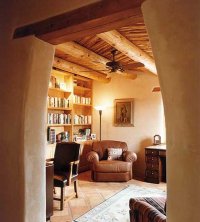adobe
Adobe is a building material made from clay, straw, and water, formed into blocks, and dried. Adobe (from the Spanish adobar, to plaster) is most economical to use in regions, such as the southwestern United States, with prevalent adobe soils and a relatively dry climate, so that bricks can be made and cured on-site. In regions that have hot, dry summers and cold winters, adobe buildings can be constructed without insulation, since the walls provide a "thermal flywheel" that moderates temperature swings and ensures a comfortable living environment. In less sunny areas, it is advisable to provide insulation, such as foam board applied to the exterior of the walls, then plastered over with stucco cement or adobe mud plaster.
 |
A major concern with adobe in areas such as California, which are prone to earthquakes, is seismic resistance. Classic adobe buildings have withstood centuries of earthquakes because their buttressed walls are relatively thick for their height, and are topped with sturdy wood beams. Modern, thin-walled adobe structures have proven to be insecure in an earthquake, unless carefully reinforced with steel and concrete, braced frequently, tied together with a beam, and securely linked to their foundations.
Adobe was the earliest building material of Egypt and Assyria, and, as well the southwestern states of the US, Mexico, and Central America, is still used in China and Japan.
